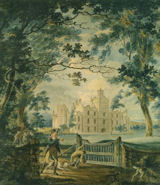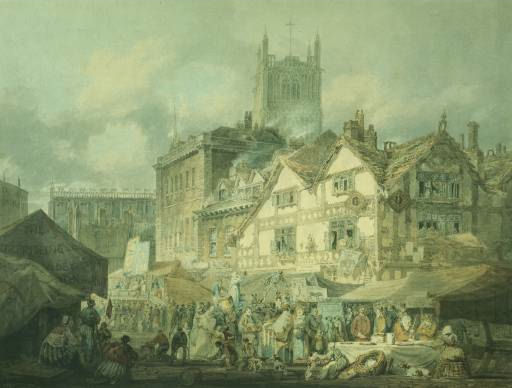




I am taking for granted that few modern readers would bother with the other Jane Austen Novels unless hoping to recapture the magical delight of sampling her masterpiece, Pride and Prejudice. Of course their hopes are destined for disappointment: while artists such as Mozart and Manet produce one masterpiece after another, Austen's first work was her best by far;
Because after completion of Pride and Prejudice, Jane Austen never attempted anything remotely resembling the scale and breadth of vision of that great Novel — rather as though the creators of the colossal Bayeux Tapestry followed up the Norman Conquest as subject by limiting themselves ever after to commissions for the fabrication of childlike embroidered samplers;
She can't have forgotten how to write, how to assemble the necessary elements:—
Consider Sense and Sensibility, written after Pride and Prejudice, but accepted for publication first. The obvious assumption is that faced with rejection of her masterpiece and acceptance of the greatly inferior second Novel, Jane Austen, like many artists before and since, decided to give her publishers what they wanted — heroines who sit around passively waiting for things to happen so that they can be seen reacting to those events. Heroines like Elinor Dashwood, of Sense and Sensibility, for example. Heaven forbid that Austen should create ever again a character of the force and perception, intelligence, confidence and wit of Elizabeth Bennet;
In Pride and Prejudice, we learn to know extremely well a veritable host of distinct personalities, exemplifying as theme the triumph of intelligence and wit over their opposite: foolishness, silliness and stupidity, with both sides wittily revealed in all their diversity and complexity by a plot that moves with the inexorability of Greek myth toward a surprising but logical culmination. The title, Pride and Prejudice, is just that — a title describing the faulty attitudes which lead to the climactic scene between Darcy and Elizabeth — and mustn't be mistaken for the theme of intelligence and wit which forms the backdrop of the entire Novel;
I believe that the title of Sense and Sensibility is even less descriptive of that Novel's contents, seeming to invoke the ancient Greeks in a call for moderation in all things — if by moderation we accept a muddled theme, poorly drawn characters, and a plot whose resemblance to Greek myth is limited to an aimless meandering that winds and wanders and stops when it runs out of sufficient energy to continue;
It might be thought that character creates theme, but Sense and Sensibility proves this to be untrue, since the lack of clearly conceived theme destroys the sense of Sense and Sensibility, and does little for its sensibility as well. A proper theme is in need of its opposite in order to function as a coherent whole. If Marianne Dashwood's seeming theatrical impulsiveness and self-indulgence had been balanced by the moderation promised by the Novel's title, all might have been well, but the overly-concerned interventions of elder sister Elinor are more apt to promote hysteria than to temper it:— better to name the book Excess and Exaggeration had Austen wished her title to represent the true spirit of the Novel;
As it is, the actual theme of Sense and Sensibility, the inescapable motif we hear over and over, is a proverb sung best in French: tout vient à celui qui sait attendre — all things come to the person who waits.
We have to wait for Northanger Abbey, written at the same time as Pride and Prejudice and Sense and Sensibility but published only after Jane Austen's death in 1817, to find a re-emergence of the assured use of those three essential components:— theme, character, and plot. With no ambiguous title to confuse us, the theme is easily discovered: how to discern the genuine and the invaluable in the words and actions of others.
As in Pride and Prejudice, the characters are well chosen to portray both sides of the literary equation. Who, after all, better to ponder the worth of effusive flatteries combined with cruel and thoughtless actions, than captivatingly innocent yet shrewd Catherine Morland as she negotiates the real and imagined social intricacies and familial inconsistencies operating in Northanger Abbey? Her simplicity throws into sharp relief the theme's opposite: snobbery, with all the falseness, hypocrisy, corruption and over-emphasis upon wealth and title comprised in that seemingly harmless and venal descriptive term;
And the plot, while lacking the complexity of that first great Novel, is adequate for its purpose of revealing theme and character. (Austen herself acknowledges some of Northanger Abbey's more obvious defects, explaining in a foreword that the fashion for gothic novels has passed, and apologizing in the Novel itself for introducing a character of convenience in the final pages);
In Pride and Prejudice, Austen makes a point of telling what is happening, then showing, then telling us again. Sense and Sensibility tells us a fair amount about Elinor Dashwood's image of herself as a paragon of all that is sensibile and moderate, but fails to show convincing evidence. Northanger Abbey, on the other hand, makes the interesting choice of showing us detail of great sublety, particularly in regard to interactions between family members, which we can grasp or let go as we choose, since we aren't specifically told what it is we are seeing;
Which leads to Mansfield Park, an insubstantial Novel of 48 chapters, and the repellent theme that only the truly perfect are worthy to be loved. Forty-eight closely-written chapters, each telling of the moral perfections of heroine Fanny Price and the failure of everyone in the vicinity (other than cousin Edmund Bertram) to acknowledge her superiority; each showing a desperately insecure young woman with an unkind (to say the least) habit of searching out and exulting in the perceived deficiencies of others;
And what is chosen as opposite to the excellence of Fanny Price as uniquely suited to be loved by Edmund Bertram? What, indeed, other than the moral failings of all the other characters, and of Miss Mary Crawford in particular. In fact, from the arrival onto the scene of the loving, frank, honest and amusing Mary Crawford, Edmund has been analyzing and deploring for the benefit of young cousin Fanny each and every one of the newcomer's sins of word and thought at the same moment as declaring his undying attachment to the lovely if unworthy newcomer — until Mary reveals herself as utterly flawed and unwilling to pretend to be anything other than what she is;
Mr. Darcy in Jane Austen's first Novel, and Captain Wentworth in her last have been wounded by the women they love; both remain constant in their affection. Mr. Knightley, hero of Emma, is unswayed by his clear recognition of the imperfections of the eponymous heroine, while Henry Tilney of Northanger Abbey accepts with equanimity the revelation that his young guest Caroline Morland suspects Henry's father of having murdered his (Henry's) mother;
It seems to a reader that each of these other men has far more reason than a pinched and humourless Edmund to set unattainable standards for the woman worthy to be his wife. The more a man brings of himself to a marriage, the more he appears willing to accept human imperfection in the woman he is to wed. While Edmund, with only his November sensibilities on offer —
... no warmth, no
cheerfulness, no healthful ease,
No comfortable feel in any member —
can love only the pallid reflection of his perceived unique purity of soul — perceived by himself and by the equally deluded Fanny Price, I hasten to add;
If it's difficult to know how Jane Austen came to write a muddled Novel like Sense and Sensibility, it's unthinkable that the author of Pride and Prejudice is responsible for the literary hatefulness that is Mansfield Park;
The two final Novels are Emma, and Persuasion, the latter also published in 1817 after Austen's death;
In Emma, the heroine struggles with a belated recognition that high social standing involves duty as well as privilege. There is nothing particularly unusual about Austen's choice of opposites in Emma, not with Mr. Knightley shown in thought and deed clearly and unmistakably demonstrating the theme's requisite sense of noblesse oblige. And should the reader be in danger of missing the point, the obliging Mr. Knightley never fails to point out the heroine's failures to measure up to the ideals he, society, and Emma herself accept as indispensable;
Jane Austen's final completed Novel, Persuasion, contains the almost brutally simple theme of constancy. The main characters of that Novel — Anne Elliot, and Captain Frederick Wentworth — appear well chosen. But when we come to examine constancy's perceived opposite, we realize, with some perplexity, that the author has selected — not changeableness, but vanity! And forces us, upon greater reflection — and closer acquaintance with the character of Sir Walter Elliot — to accept her judgment, if not to receive it with perfect comprehension.
[As for Lady Susan, a brief wickedly-funny epistolary novel written in Austen's youth and never submitted for publication during her lifetime, it's probably unfair to hold this short piece to any type of organized criticism — and yet for my purposes it contains a theme (ruthlessly appropriating what doesn't belong to you), altruism its opposite, fairly well-drawn characters, and a purposeful plot.]
* * * * *
It's clear from this short summary that the themes in Jane Austen's Novels are no less important from first to last. But few can argue that the Novels themselves become infinitely less powerful. Pride and Prejudice is not merely a Novel of wit, and intelligence, but also of perception, and judgment, and idealism, and courage. That the Novel is composed of all these qualities is due to one factor alone: every aspect of the story is filtered through the unique viewpoint of its heroine. A similar filtering takes place in every subsequent Austen Novel, never for better, and usually for much worse;
Where the energetic Elizabeth Bennet is ironically aware of and interested in everything happening in her immediate vicinity, the other heroines are incapable of such expansive scope of attention. There is no lack of interest in her surroundings in exciting Bath and gloomy Northanger Abbey on the part of Catherine Morland, but her extreme youth and inexperience act as barriers to perfect comprehension of the events transpiring around her.
Sense and Sensibility and Mansfield Park are afflicted by problems of a more sinister nature, the heroines of these Novels being concerned first and foremost in concealing their true natures as revealed by thought and reaction.
That is to say that the hazy confusion of Sense and Sensibility is a result of Elinor Dashwood's need to present herself in perfect control of the unavoidable and tragic situations in which life is placing her as we watch appalled. We may not like Elinor Dashwood — mainly because she makes no attempt to win our affection, and would bitterly resent our pity. Nevertheless we have no choice but to offer her a certain earned if grudging respect.
But the picture we are given of life at Mansfield Park is as warped as its heroine by the need to present a false and idealized image, to herself, and to those about her.
Meanwhile, Emma is marked by faulty perception and the arrogant cruelty of youth, and Persuasion by the lack of a credible hero, Captain Frederick Wentworth being more an ideal than a living breathing human person.
In the next section I offer my solution to the mystery of Jane Austen's seemingly incomprehensible varying literary output. Yes, Jane Austen died young and her later years must have been racked by the effects of pain and illness. But I believe another factor to be at work, as I intend to explain to the best of my ability.
Details of and links to all Austen-Novel Pictures are found in the Pictures 3B webpage.
This Page:— The Seven Very
Different Novels of Jane Austen
 JMW Turner, c. 1787
JMW Turner, c. 1787
Title: View of Nuneham Courtenay from the Thames
[From Oxford and Other Subjects]
Medium: Gouache, graphite and watercolour on paper
Dimensions: Support 320 x 451 mm
Collection: Tate, Accepted by the nation as part of the Turner Bequest 1856
View by appointment at Tate Britain's Prints
and Drawings Room
Reference: D00002 Turner Bequest 1B
 JMW Turner, c. 1791
JMW Turner, c. 1791
Title: Cote House, near Bristol
Watercolour and pen on paper
Dimensions: Support 292 x 255 mm
Collection Trustees of the Cecil Higgins Art Gallery, Bedford, England
Turner Worldwide, Reference TW 0015, Wilton 21
In 1791, JMW Turner would have been been no more than sixteen years old.
 JMW Turner, 1815
JMW Turner, 1815
Title: Front Door and Porch, Farnley
Medium: Bodycolour on paper
Dimensions: unconfirmed 268 x 320 mm
Private Collection, Turner Worldwide
Reference: TW0237, Wilton 584
 JMW Turner, exhibited 1796
JMW Turner, exhibited 1796
Title: Woolverhampton, Staffordshire (High Green, Wolverhampton)
Medium: Watercolour and pen on paper
Dimensions: Support 318 x 419 mm
Collection Wolverhampton Art Galleries and
Museums
Turner Worldwide, Reference TW0860, Wilton 139
________________________